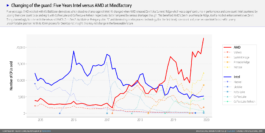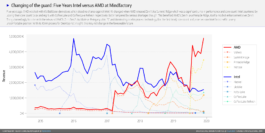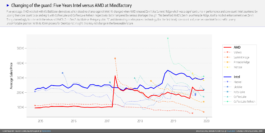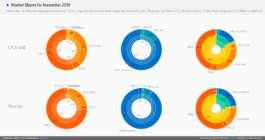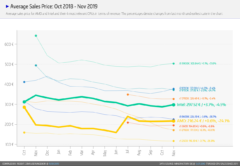AMD has been breaking records left, right and center and if you thought this the highest the company can go then I have news for you. The company just achieved a new record for its sales at Germany's largest retailer: Mindfactory.de. Clawing even more market share from Intel, the company clocked in at 82% of total CPU sales in November 2019, up from 78% in October. The market share increase was led primarily by the Ryzen R7 3700X and R5 3600X processors.
Mindafctory.de: AMD reaches an all-time record of 82% of all CPUs sold in November 2019
In terms of total revenue, AMD processors accounted for 77% of all processors sold due to a lower ASP (average selling price) than their Intel counterparts while Intel clocked in at 23%. When speaking in terms of the total number of processors sold, however, AMD clocked in at 82% representing more than 25000 processors sold during the month of November while Intel CPUs shipped in an average quantity of ~5000.

The data also shows that the market share increase was led primarily by AMD's brand new 3rd generation 7nm processors, namely the Ryzen R7 3700X (8-core/16-thread) and Ryzen R5 3600X (6-core/12-thread). This is a trend that was reflected in our survey as well with 8-cores generally being the new "mainstream" core-count for the vast majority of the market. With AMD's cheaper pricing and value-oriented pricing philosophy, Intel's clock speed lead is quickly becoming irrelevant as more and more users prefer to get red CPUs.

One very interesting thing I noticed was that if you take a look at the graphs, the positioning in November 2019 looks roughly the same as the positioning in late 2016 when AMD was not fully competitive yet. A very real changing of the guard has happened and the tables have been turned almost completely on the once unbeatable Intel. Intel's 9900KS still remains the processor with the highest ASP and I personally think that if Intel wants to retain whatever market share it has left, it needs to go for a second round of price cuts and actually follow the value-oriented philosophy now.
Germany isn't the only country where AMD has been absolutely shattering records. The company owns 8 out of 10 processors on Amazon's best selling list. The best selling AMD processor is the second generation Ryzen 2700X which offers an incredible per-core price of a mere $23 USD. Intel's best selling processor, the 9900K, on the other hand, represents a significantly higher $58 USD per core figure. It is worth noting that while the 9900K is superior in terms of gaming performance, the performance difference isn't anywhere close to the price difference.
The fact that two of AMD's second-generation processors are offering performance levels in the ballpark of Intel's 9th generation offerings at less than half the per-core pricing is telling of the dilemma Intel faces. With AMD's third-generation processors now offering not only higher perf-per-dollar figures but higher absolute value as well, Intel will soon have no option but to undercut prices once more or yield a ton of market share.
With 10nm not slated to launch till late 2020 and rumors that it is still not ready, we might not see blue competitive again till they transition to EUV with the 7nm node sometime in 2021-2022. It goes without saying that unless Intel starts slashing pricing fast, it's going to lose pretty much all of its market share by that point.
While Intel is still technically the larger company in terms of revenue, this precarious positioning and current trends put all of that at risk. It doesn't help that they still cannot meet market demand for their existing 14nm products either. 2020 is clearly going to be a big opportunity for AMD and one of the most challenging years for Intel to navigate.
The one thing that Intel has going for it right now is its plans to diversify into the GPU side by late 2020, this is something that can help it massively in terms of overall risk and allow it to utilize its processes for GPUs as well. With AMD's RTG side pretty much on cruise-mode, Intel has a real chance to play catch up on that side and execute a come back of its own.

